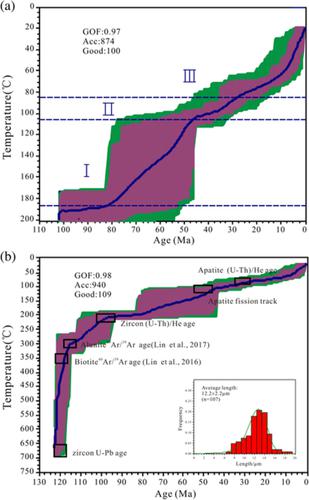当前位置:
X-MOL 学术
›
Resour. Geol.
›
论文详情
Our official English website, www.x-mol.net, welcomes your feedback! (Note: you will need to create a separate account there.)
Low Temperature History of the Tiegelongnan Porphyry–Epithermal Cu (Au) Deposit in the Duolong Ore District of Northwest Tibet, China
Resource Geology ( IF 1.4 ) Pub Date : 2019-11-08 , DOI: 10.1111/rge.12221 Huanhuan Yang 1 , Yang Song 1 , Juxing Tang 1 , Qin Wang 2 , Ke Gao 2 , Shaogang Wei 3
Resource Geology ( IF 1.4 ) Pub Date : 2019-11-08 , DOI: 10.1111/rge.12221 Huanhuan Yang 1 , Yang Song 1 , Juxing Tang 1 , Qin Wang 2 , Ke Gao 2 , Shaogang Wei 3
Affiliation

|
The Tiegelongnan is the first discovered porphyry–epithermal Cu (Au) deposit of the Duolong ore district in Tibet, China. In order to constrain the thermal history of this economically valuable deposit and the rocks that host it, eight samples were collected to perform a low‐temperature thermochronology analysis including apatite fission track, apatite, and zircon (U‐Th)/He. Apatite fission track ages of all samples are between 34 ± 3 and 67 ± 5 Ma. Mean apatite (U‐Th)/He ages show wide distribution, ranging from 29.3 ± 2.5 to 56.4 ± 9.1 Ma. Mean zircon (U‐Th)/He ages range from 79.5 ± 12.0 to 97.9 ± 4.4 Ma. The exhumation rate of the Tiegelongnan deposit was 0.086 km m.y.−1 between 98 and 47 Ma and decreased to 0.039 km m.y.−1 since 47 Ma. The mineralized intrusion was emplaced at a depth of about 1400 m in the Tiegelongnan deposit. Six cooling stages were determined through HeFTy software according to low‐temperature thermochronology and geochronology data: (i) fast cooling stage between 120 and 117 Ma, (ii) fast cooling stage between 117 and 100 Ma, (iii) slow cooling stage between100 and 80 Ma, (iv) fast cooling stage between 80 and 45 Ma, (v) slow cooling stage between 45 and 30 Ma, and (vi) slow cooling stage (<30 Ma). Cooling stages between 120 and 100 Ma are mainly caused by magmatic–hydrothermal evolution, whereas cooling stages after 100 Ma are mainly caused by low‐temperature thermal–tectonic evolution. The Bangong–Nujiang Ocean subduction led to the formation of the Tiegelongnan ore deposit, which was buried by the Meiriqiecuo Formation andesite lava and thrust nappe structure; then, the Tiegelongnan deposit experienced uplift and exhumation caused by the India–Asia collision.
更新日期:2019-11-08



























 京公网安备 11010802027423号
京公网安备 11010802027423号